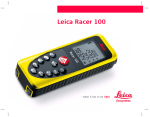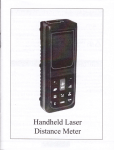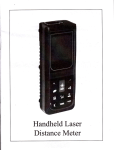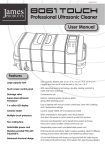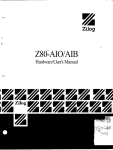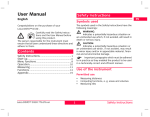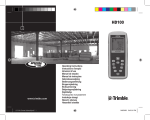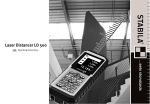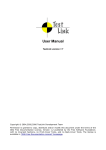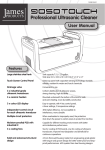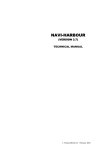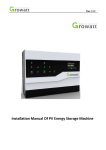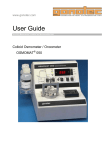Download Operation Manual-ver2
Transcript
Operation Manual Hand-Held Laser Distance Meter DI-900 PLEASE READ THIS MANUAL CAREFULLY BEFORE OPERATION 3, Hagavish st. Israel 58817 Tel: 972 3 5595252, Fax: 972 3 5594529 [email protected] MRC.08.14 Safetv Instructions User Manual Symbols used The symbols used in the Safety Instructions have the following meanings: English Congralulalions on the purchase of your products. Carefully read the Safety Instructions and the User Manual before using this product. ^\l The person responsible for the / • i \4r~J instrument must ensure that all users understand these directions and adhere to them. AWARNING: Indicates a potentially hazardous situstion or an unintended use which, if not avoided, will result in death or serious injury. Contents Safety Instructions Start-up Menu functions Operation Measuring Functions Appendix 2 7 11 12 13 15 21 A CAUTION: Indicaes a potentially hazardous situation or an unintended use which, if not avoided, may result in minor injury and/ or in appreciable material, financial and environmental damage. Important paragraphs which must be adhered to in practice as they enabled the product to be used in a technically correct and efficient manner. Use of the instrument Permitted use Measuring distances Computing functions, e.g. areas and volumes Indirect measurement Addition and subtraction operations of measurement Prohibited use • Using the instrument without instruction. • Using outside the stated limits. • Deactivation of safety systems and removal of explanatory and hazard labels. • Opening of the equipment by using tools (screw drivers, etc.), as far as not specifically permitted for certain cases. • Carrying out modification or conversion of the product. • Use after misappropriation . • Use of accessories from other manufacturers without the express approval of our company. • Deliberate or irresponsible behaviour on scaffolding, when using ladders, when measuring near machines which are running, or near parts of machines or installations which are unprotected. • Aiming directly into the sun • Deliberate dazzling of third parties; also in the dark • Inadequate safeguards at the surveying site (e.g.when measuring on roads, construction sites, etc.) Limits of use See section "Technical Data ". The poduct is designed for use in areas perm nently habitable by humans, do not use the product in explosion hazardous areas or in aggressive environments. Areas of responsibility As the original producer responsibility: Responsible for providing security products include manual and origin of the parts. Responsibilities of the manufacturer of non-Original accessories: The manufacturers of non-Original accessories . for the products are responsible for developing, implementing and communicating safety concepts for their products. They are also responsible for the effectiviness of these safety concepts in combination with the products equipment. Responsibilities of the person in charge of the instrument: A WARNING The person responsible for the instrument must ensure that the equipment is used in person is also accountable for the deployment of personnel and for their accordance with the instructions. This training and for the safety of the equipment when in use.The person in charge of the instrument has the following duties: • To understand the safety instructions on the product and the instructions in the User Manual. • To be familiar with local safety regulations relating to accident prevention. • To inform Leica Geosystems immediately if the equipment becomes unsafe. Hazards in use A CAUTION: Watch out for erroneous distance measurements if the instrument is defective or if it has been dropped or has been misused or modified. Precautions: Carry out periodic test measurements. Parti- cularly after the instrument has been subject to abnormal use, and before, during and after important measurements. Make sure the optics is kept clean and that there is no mechanical damage to the bumpers. A CAUTION: In using the instrument for distance measurements or for positioning moving objects (e.g. cranes, building equipment, platforms, etc.) unforeseen events may cause erroneous measurements. Precautions: Only use this product as a measuring sensor, not as a control device. Your system must be configured and operated in such a way, that in case of an erroneous measurement, malfunction of the device or power failure due to installed safety measures (e.g. safety limit switch), it is assured that no damage will occur. A WARNING: Flat batteries must not be disposed of with household waste. Care for the environment Always prevent access to the product by unauthorized Dersonnel. and take them to the collection points provided in accordance with national or local provided in accordance with national or local regulations.The product must not be disposed of wit household waste.Dispose of the product appropriately in accordance with the national regulations in force in your country. Electromagnetic Compatibility (EMC) The term "electromagnetic compatibility" is taken to mean the capability of the product to function smoothly in an environment where electromagnetic radiation and electrostatic discharges are present, and without causing electromagnetic interference to other equipment. •^WARNING: The products conforms to the most stringent requirements of the relevant standards and regulations. Yet, the possibility of it causing interference in other devices cannot be totally excluded. AcAUTION: Never attempt to repair the product yourself. In case of damage, contact the local dealership. Laser classification Integrated distancemeter The produces a visible laser beam which emerges from the front of the instrument. It is a Class 2 laser product in accordance with: • IEC60825-1 : 2007 "Radiation safety of laser products"Laser Class 2 products: Do not stare into the laser beam or direct it to wards other people unnecessarily. Eye protection is normally afforded by aversion responses including the blink reflex. ^WARNING: Looking directly into the beam with optical aids (e.g. binoculars, telescopes) can be hazardous. Precautions: Do not look directly into the beam with optical aids. ^CAUTION: Looking into the laser beam may be hazardous to the eyes. Precautions: Do not look into the laser beam. Make sure the laser is aimed above or below eye level, (particularly with fixed installations, in machines, etc.) 2 Insert batteries, observing correct polarity. 3 Close the battery compartment again. Replace the batteries when the symbol 3 flashes permanently in the display. Only use alkaline or rechargeable batteries. Remove the batteries before any long period of non-use to avoid the danger of corrosion. Labelling Changing the reference point (multifunctional endpiece) Start-up Inserting/replacing batteries 1 Remove battery compartment lid and attach handstrap. The instrument can be adapted for the following measuring situations: • For measurements from an edge, fold out the positioning bracket until it first locks in place. • For measurements from a corner, open the positioning bracket until it locks in place, then push the positioning bracket lightly to the right to fold it out fully. A built-in sensor automatically detects the orientation of the positioning bracket and adjusts the zero point of the instrument accordingly. • For measurements from an edge, fold out the positioning bracket until it first locks in place. • For measurements from a corner, open the positioning bracket until it locks in place, then push the positioning bracket lightly to the right to fold it out fully. A built-in sensor automatically detects the orientation of the positioning bracket and adjusts the zero point of the instrument accordingly. Display 1 2 3 4 5 6 7 8 9 10 11 12 13 Laser active Reference Indirect measurement (Pythagoras) Delay measurement Area volume measurement Stored record Data display Display unit Battery status Hardware failure The dynamic continuous measurement Marking function Operation error indication Keypad B ON / DIST (On/measuring) - button Q| Plus (+) - button B Minus (-) - button ^3 Area/volume-button ^J Angle button (9 Reference-button r © Indirect measurement (Pythagoras) - button E9 Background light/ Units—button 19 Storage-button O Timing button 0 Clearn/off-button i -aaaaas Battery state indicator IOD Battery 100% SD Battery?5% ID Battery50% Battery25% BatteryO% Standard supply part Laser Distance Meter 1 portable belt 2 1 1 1 battery operating instructions protective bag warranty card Menu functions Measurements PI button (pressed long) - Press once again to change the unit of distance measurement. The following units are available: m (meter), ft (feet), in (inch), ft +/ in (feet - inch 1/16). Beep ^) button (press long). You can choose the beep on or off as required. Laser Continuous (—x) IB Press and hold down the key when switching on the device until the character T appears permanently in display with beep sounds. Every further press of the key releases a distance measurement, ^j Press the key and hold to switch the device and laser continuous operation off. can be shown on the display. Illuminating display pjj button (press short), the illuminating display can be turned on or off. The Correction of tilt sensor Press this button Bj| to enter into the "Tilt sensor" mode. Continuously press this button ^3 nve times again when the bottom of display shows 0.0; Then press button H once to see the display shows 0.1. Wait for five seconds and rotate the instrument by 180 degree. Press the button H once and it shows 0.2; wait several seconds till it shows 0.0 for finishing the correction. Press this button ^9 for exiting. Operation Switching on and off Switches on the instrument and laser. The dLsjjlay shows the battery symbol until the next button is pressed. Pressing this button for longer switches the instrument off.The instrument switches off automatically after three minutes of inactivity. Clear button Measuring with tripod ^P The last action is cancelled. While making area or volume measurements, each single measurement can be deleted and remeasured in series. The reference must be appropriately adjusted in order to be able to take correct measurements with a tripod. You can switch the reference by ^B button. The setting The default reference setting is from the rear of the Refenece setting instrument.The display will show you. ^| Press this button, a measurement will be extended along as the reference edge. The display will show youiL. ^9 Press this button, will measure the reference edge fixed to the forefront. The display will show you! . ^9 Press this button, the rear reference is set again. Level You c a n c h o o s e t h e l e v e l g a u g e o n o r o f f a s r e q u i r e d b y p r e s s t h i s b u t t o n i^J) Measuring a ngle distance measurement Press to activate the laser. ^J Press again to trigger the distance measurement. The result is displayed immediately. Tilt measurement The tilt sensor measures tilts between ± 45° . Q? During the measurement of tilt, the instrument should be held without transverse tilt, as far as possible, ( ± 10° ). Horizontal measurement ^^ Press button to activate horizontal measurement in the instrument. The following symbol appears in the display^O- . If the button is active, the horizontal distance is displayed in the summary line for each distance measurement (up to max. +/-45° and up to max. a transverse tilt of + / - 1 0 0 ). Press the button to collect the measurement data, the data will be on the display. And the height distance, horizontal distance, hypotenuse distance and angle will be showed on auxiliary display in turn. S Timer (self-triggering) ^9 Press this button to set a 5-second time delay. orQQ Press and hold down this button until the desired time delay is reached (max. 30 seconds).Once the key is released the remaining seconds until measurement (e.g. 29, 28, 27...) are displayed in a countdown. The last 5 seconds are counted down with a beep. After the last beep the measurement is taken and the value is displayed. timer can be used for all measurements. Minimum/maximum measurement This function allows the user to measure the minimum or maximum distance from a fixed measuring point. It can also be used as to determine spacings.lt is commonly used to measure room diagonals (maximum values) or horizontal distances (minimum values). H Press and hold down this button until you hear a beep. Then slowly sweep the laser back and forth and up and down over the desired target point(e.g. into the corner of a room). Press to stop continuous measurement. The les for maximum and minimum distances are shown in the display as well as the last measured value in the summary line. S H Press it again to take the second length measurement (e.g. width). The result is displayed in the summary line. Volume \s Addition /subtraction Distance measuring. H The next measurement is added to the previous one. ^p The next measurement is subtracted from the previous one.This process can be repeated as recruired. B The last step is cancelled. Area Cl Press once. The/i£li/symbol appears in the display. j^ Press this button to take the first length measurement (e.g. length). Q| Press this button twice. The^symbol appears in the display. • Press this button to take the first length measurement (e.g. length). | Press this button to take the second length measurement (e.g. width). f Press this button to take the third length measurement (e.g. height). The volume then appears in the summary line. Tilt measurement (^ Long press this button once to activate the tilt sensor.The tilt degree data and tilt symbol tor* appears in the display. H Press to measure the inclination and the distance. Indirect measurement The instrument can calculate distances using Pythagoras' theorem. Make sure you adhere to the prescribed sequence of measurement: • Al 1 target points must be in a horizontal or vertical plane. • The best results are achieved when the instrument is rotated about a fixed point (e.g. with the positioning bracket fully folded out and the instrument placed on a wall). • The minimum/maximum function can be used - see explanation in "Measuring -> Minimum/maximum measurement". The minimum value must be used for measurements at r ight angles to the target; the maximum distance for all other measurements. measurement.After the first measurement the value is adopted. The result is displayed in the summary line,the partial results in the secondary line.(Such as:angle and distance.) If bevelangle>45° ,Need to measure (2) . (^ Press this button,closed angle sensor, Shall be measured again point ( 1) in the distance.After the measurement is completed, Keep the instrument as horizontal as possible. £ Press and hold down this button to trigger continuous measurement, sweep the laser back and forth and up and down over the ideal target 'nt. Press to stop continuous measurement (2). The result is displayed in the summary line, the partial results in the secondary line. (Such as:bevel edge and angled edge distance.) t sure that the first measurement and the distance to be measured are at right angles. Use the Minimum/maximum function, as explained in "Measuring -> Minimum/ maximum measurement". Indirect measurement - determining a distance using 2 auxilliary measurements e.g. for measuring building heights or widths. It is helpful to use a tripod when measuring heights that require the measurement of two or three measurements. Press this button once, the display laser is switched on. Aim at the upper point (1) and trigger the Indirect Measurement - determining a distance using 3 measurements ^J Press this button twice; the display shows the following symboM.The laser is switched on. Aim at the upper point (1) and trigger the measurement. After the first measurement the value is adopted. The result is displayed in the summary line,the partial results in the secondary line. (Such as:angle and distance.)If bevel angle>45° ,Need to measure (2) . ^J Press this button,closed angle sensor,Shall be measured again point ( 1) in the distance. After the measurement is completed, Keep the il^trument as horizontal as possible. | Press and hold down this button to trigger continuous measurement, sweep the laser up and down over the ideal target point. Press to stop continuous measurement (2K The e is adopted. Aim at the lower point and | | Press this button to trigger the measurement (3). The result is displayed in the summary line, the partial results in the secondary lines. Storage of constants/historical storage Historical storage 1^ Press this button for long time, the icon ( £ ) will show on the display , and the previous 10 results (measurements or calculated results) are shown in reverse order. The^^and^Jbuttons can be used for navigation. Make it available constant for further calculations by pressing^S button. Technical data endix ITEM Message codes Measuring range All message codes are displayed with either or "Error". The following errors can be corrected: Measuring accuracy Display accuracy Laser classification .aser type Icon * Cause Calculation error, Receiving the reflected light too weak or too strong, Measurement time too long Remedy 100m instrument 0.05 80m instrument to 100 M* 0.05 Typical ± 2 mm ** 1 mm j 1 mm Class 2M II Class 2M II 620-690nm< 1mW 620-690nm,<1mW ^l Distance measurement with tilt sensor • Reoperation, change a better surface reflecting or using target plate. to 80 M ' Typical ± 2 mm" • -lorizontal measurement range ±45° ±45" Horizontal measurement accuracy ±0.3° ±0.3° Area, Volume measuring ndirect measurement 3ythagoras • • • • • • • • • • • • proposition ^lus-minus method The goal of the ambient light is too strong ^^^ 1 Continuous measurement Change the light for measuring. - Minimum / maximum measurement Display illumination Show beep Cool down or Warm up Temperature too high ( +40"C ) or the instrument, External Temperature will be too low { 0"C ) available from 0°C to +40 = C. Switch on / off the Multifunctional end piece Protection against splashes and du t Historical storage Temperature range for Operation Temperature fange for Storage Battery life 2800 Hardware error If the symbol still appears, then your instrument may be defective. Please call your dealer for assistance. 3attery selection Laser switch-off automatically • • • • Automatically Automatically IP54 IP 54 10 10 Or to +4CTC O'C to +4CFC -20'C to +7CTC 5000 to 8000 measurements -20'C to +70r 5000 to 8000 measurements LR6 (AA) 2 * 1 .5V LR6(AA)2 x 1.5V After 30 seconds After 30 seconds instrument switch-off automatically After 3 minutes After 3 minutes Dimensions 118 *49 *27 mm 118 "49*27 mm Weight Weight 150g ( without battery ) 150g ( without battery ) * maximum deviation occurs under unfavourable conditions such as bright sunlight or when measuring to poorly reflecting or very rough surfaces. Measuring accuracy between 10m and 30 m may deteriorate to approx. ± 0.025 mm/m, for distances above 30m to ± 0.1 mm/m. Measuring conditions Measuring range The range of 100m instrument is limited to 100m.The range of 80m instrument is limited to 80m. At night or dusk and if the target is in shadow the measuring range without target plate is increased. Use a target plate to increase the measurement range during daylight or if the target has poor reflection properties. Target surfaces Measuring errors can occur when measuring toward colourless liquids (e.g. water) or dust free glass, Styrofoam or similar semiperme-able surfaces. Aiming at high gloss surfaces may deflect the laser beam and lead to measurement errors.Against non-reflective and dark surfaces the measuring time may increase. Care Do not immerse the instrument in water. Wipe off dirt with a damp, soft cloth. Do not use aggressive cleaning agents or solutions. Handle the instrument as you would a telescope or camera. Warranty The instrument comes with a one-year warranty. This warranty effective premise is: according to the company's operating instructions for correct operation, processing,cleaning and maintenance of the tool, and the tool is maintained good technical condition.This means that in the tool can be used in the company's original components and spare parts.This warranty is provided in the tool during the whole life expectancy of the defective parts of the repaired or replaced free of charge.If the component due to normal wear and in need of repair or replacement, is not in the warranty van. All illustrations, descriptions and technical specifications may be subject to change without prior notice.













